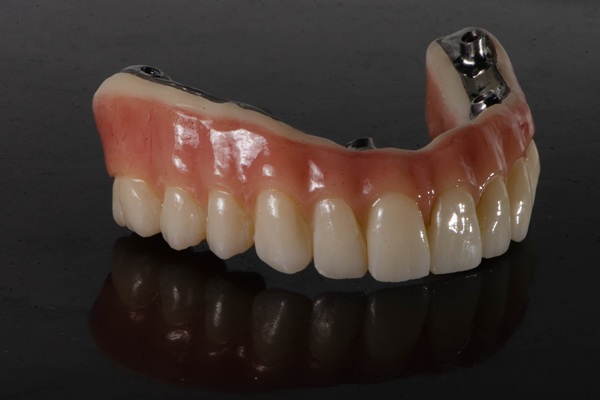The Steps of an All-on-4 Dental Procedure

Getting the All-on-4® overdentures procedure done involves a dentist implanting four titanium screws or rods into the upper and lower jawbone. This is a more stable alternative to removable partial dentures. It can be not easy to eat or speak with removable dentures, but with permanent dentures, patients can have more freedom and comfort while eating and speaking. This article will outline the steps of the All-on-4 procedure. It is important for patients to understand this treatment option so they can better determine if it is a good choice for them.
Consultation
A consultation appointment is the first step to getting this procedure. This is the time when all questions will be answered and patietns should walk away with a complete understanding of what they can expect before, during, and after the procedure. During this visit, the dentist will evaluate the patient's teeth and gum health through an oral examination. The dentist may also need to take dental X-rays and perform a CBCT (cone beam computed tomography) scan to see the status of underlying structures. The dentist will also discuss the medications taken, the patient's health condition, and their medical history. This assessment will confirm whether a patient is a good candidate for implant surgery.
Before the end of the consultation, the dentist will present a treatment plan. If the patient agrees with the treatment plan, the dentist will schedule the implant surgery procedure. The dentist may also want to discuss pre-operative matters with the patient, as well. This would require a separate meeting where the dentist would cover preparation, prescriptions, and dental sedation.
Patients should go to this consultation prepared to ask any questions that they may have. Some people prefer to bring someone with them so that they also have a clear understanding of how recovery will look.
Implant surgery
It is suggested that patients should wear comfortable clothes and shoes on the day of their procedure. This can help patients relax. and feel at ease throughout the entire process. Patients should anticipate that the effects of sedation will take a while to wear off, and they should have someone to drive them home after the procedure. The dentist will start by prepping patients with sedation. Once the sedation takes effect, the dentist will remove all the patient's remaining teeth. Then, the dentist will make incisions into the gums to shape the sockets for the titanium rods or screws.
The dentist will then attach the titanium rods into the sockets. After that, the dentist will connect abutments to the roots and stitch of the patient's gums closed. Whether it is the upper arch, lower arch, or both arches, only four dental implants will be used for each arch.
Healing
Recovery is very important in the success of the procedure. It is important to note that recovery may vary slightly fro one person to the next simply because people respond differently to sedation and surgery. It is natural for patients to experience some swelling and soreness, but they will be able to manage their symptoms with an over-the-counter pain reliever. Healing usually takes three to six months. During this time, the osteointegration process takes place. Osteointegration is the process of the titanium rods being absorbed and fully integrated into the jawbone. During this healing period, patients should eat soft foods that do not require much chewing. The dentist can provide more information about which foods to eat and which ones to avoid during the recovery process.
Bleeding may still occur even after patients get home. Once the bleeding stops, patients should rinse their mouth with warm salt water two to three times daily. It is recommended not to drink alcohol or smoke tobacco, as these habits slow down the healing process.
Chewing too much can loosen the implants, preventing proper healing and osteointegration. Patients should follow all aftercare instructions thoroughly. Patients and their dentist can only continue the procedure if there is an appropriate merging of bone, gums, and titanium rods.
After osteointegration, the next step in the procedure is to be fitted with dental crowns that will replace the natural teeth.
Discuss options with a dentist
All-on-4 offers more stability than traditional dentures. This may prove to be a great option for those who would like more support than traditional dentures, and need upgrade their smile. Potential patients should consult a dentist to ask about this procedure.
Request an appointment here: https://www.islandparadisedental.com or call Island Paradise Dental at (239) 465-4999 for an appointment in our Marco Island office.
Check out what others are saying about our dental services on Yelp: All-on-4 Dental Implants in Marco Island, FL.
Related Posts
All-on-4® dental implants provide an innovative, natural-looking solution for patients experiencing extensive tooth loss. Unlike traditional dentures, this treatment combines the permanence and stability of implants with the efficiency of a streamlined design. A general dentist is often the first to identify candidates for this treatment, helping to coordinate care and ensure patients achieve lasting…
For people with gaps in their mouth due to missing teeth, dental implants can be a great replacement method. Implants provide a wide variety of benefits, and they last a long time. However, the procedure is more invasive than others, and it is not a good option for every patient. When considering them as a…
For those considering partial dentures to replace missing teeth, it is helpful to have all of their questions answered during the consultation so they can decide on the best way to replace the missing teeth. This review discusses the best questions to ask your dentist about partial dentures.Before patients reach out to the dentist to…
Partial dentures with dental implants offer a long-term solution to replacing a section of missing teeth. This is a great replacement solution even if you have multiple teeth that are missing, as it utilizes two or more dental implants to support the partial denture rather than having the dentures rest upon and be supported by…












